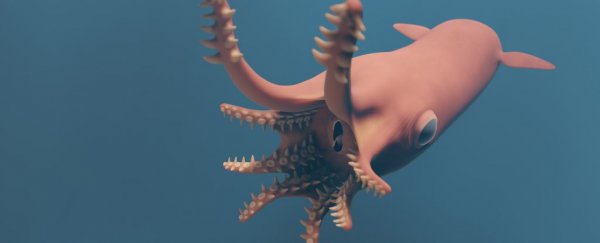A fearsome 'vampire' predator that lurked in Earth's oceans more than 160 million years ago probably did actually suck its prey, at least in a sense.
A new analysis of exceptionally well-preserved fossils of a small cephalopod named Vampyronassa rhodanica, related to modern vampire squids (neither actually vampires, nor squids), reveals the presence of muscular suckers that the beastie likely used for snaring and manipulating prey.
In other words, it was an active predator, hunting the pelagic depths for tasty morsels.
This is in direct contrast to the animal's present relatives, Vampyroteuthis infernalis, whose suckers seem largely non-functional, and which collect drifting flakes of organic material using sticky cells on a pair of specialized, thread-like appendages.
"The contrast in trophic niches between the two taxa is consistent with the hypothesis that these forms diversified in continental shelf environments prior to the appearance of adaptations in the Oligocene leading to their modern deep-sea mode of life," writes a team of researchers led by paleontologist Alison Rowe of Sorbonne University in France.
Mushy animals like cephalopods are pretty scarce in the fossil record. Soft tissues don't fossilize as readily or well as bones, which makes fossils, especially good fossils, very rare.
Rare doesn't mean nonexistent, however, and Rowe and her colleagues were able to study three V. rhodanica fossils from a lagerstätte (sedimentary deposit) dating back to over 160 million years ago in La Voulte-sur-Rhône in France. This is a type of very fine sedimentary fossil bed that is exceptionally good at preserving fossils, including soft tissue.
Even soft tissue preserved in this way isn't always easy to parse. To understand the anatomy of V. rhodanica, Rowe and her team took the fossils to the European Synchrotron Radiation Facility in France to undergo non-invasive 3D imaging.
 One of the exceptional fossils of V. rhodanica. (P. Loubry, CR2P)
One of the exceptional fossils of V. rhodanica. (P. Loubry, CR2P)
"The fossils are on small slabs, which are very difficult to scan," Rowe explains.
"On top of that, soft tissues are preserved but we needed phase contrast imaging to visualize the faint density variation in the data. The coherence of ESRF beamline ID19 was therefore very important to perform propagation phase-contrast computed-tomography and track all the minute details, such as the suckers and small fleshy extensions, called cirri."
The scans revealed some interesting differences between V. rhodanica and V. infernalis, which is now the only living member of the Vampyromorph order.
Both are relatively small (the former just 10 centimeters or 4 inches in length), with oval bodies flanked by two small fins. Both also have small, fleshy projections called cirri emerging from their arms.
Yet there were no signs of the thread-like food snares on any of the V. rhodanica fossils – instead an extended pair of arms with a unique arrangement of suckers.
On the tips of these two specialized dorsal arms, it sports more robust, muscular cirri and suckers. V. infernalis has smaller cirri, and its suckers appear only on the ends of their arms farthest from their bodies. What's more, they appear to be passive; it doesn't use them for grasping prey.
"We believe that the morphology and placement of V. rhodanica suckers and cirri in the differentiated arm crown allowed V. rhodanica increased suction and sensory potential over the modern form, and helped them to manipulate and retain prey," Rowe says.
In other words, V. rhodanica has the equipment to be an active predator in the pelagic seas, with more sensitive sensory organs and the ability to grasp prey. V. infernalis is more peaceful and opportunistic.
Although related, the two species occupy different ecological niches… neither of which is actually anything to do with vampirism. Oh well.
By the Oligocene, about 30 million years ago, vampire squids were already in the depths, lurking about, waiting for organic debris to rain down into their hungry arms.
Sometime in the intervening millions of years, vampire squids made a significant lifestyle change. How and why this happened will need to be the subject of future research… if the fossils can be found.
The team's research has been published in Scientific Reports.
